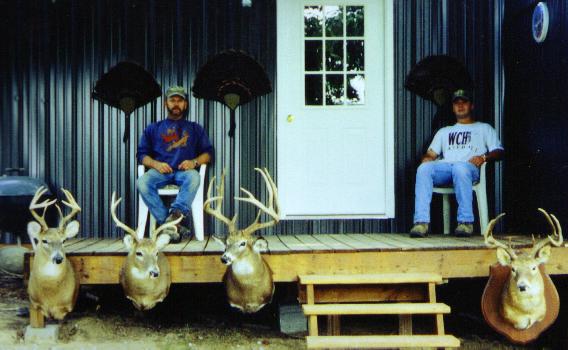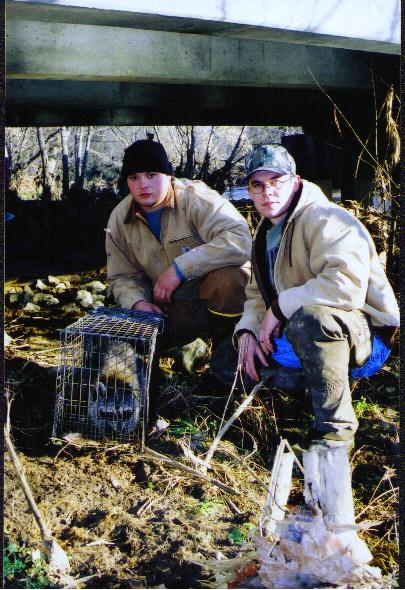FALL 2001


|
WOODY DEBRIS RACHEL KOESTER AND SARA VIERNUM We sought to determine which type of habitat Peromyscus leucopus, white-footed mouse, prefers. Two specific areas were compared, those containing coarse woody debris (CWD) and those containing non-coarse woody debris (NCWD). CWD includes downed dead trees and thick shrubby undergrowth. NCWD is clear of downed dead trees and had minimum to no thick shrubby undergrowth. Studies were conducted by permit at Terrapin Creek State Nature Preserve. Four sites were chosen; two CWD and two NCWD. A total of 120 Sherman Box Traps were set; 30 traps at each site. We hypothesized that more P. leucopus would be captured in the two sites with CWD, than in the NCWD sites. Reasons for this were that we believed that P. leucopus prefer habitat with more CWD due to the fact that this habitat offers more protection from exposure to predation. Results showed that CWD is the preferred habitat due to the two CWB sites having a higher capture rate.
|
 |
 |
CRYSTAL L. ROSE This study used fossil material of Microtus pinetorum to investigate Bergmann's Rule. Specimens were collected from Cutoff Cave and Hilltop Cave, Trigg County, Kentucky in 1994. Cutoff Cave represents a brief period in the Holocene and Hilltop Cave is a Pleistocene deposit C-14 dated to about 30,000 years. For comparison, modern specimens were attained from the MSU collections. The lower, first molar was measured because it is identifiable down to species level, and its length has previously been proven an indirect indicator of body mass. In this study, an ANOVA test was used to compare the data. A significant P-value was attained both when comparing Cutoff Cave with modern specimens as well as Hilltop Cave with modern specimens. Therefore, the null hypothesis was rejected and an alternative hypothesis adopted. The results of this experiment are consistent with Bergmann's rule that individuals have increased body mass in cold climates. |
|
JONATHAN HARDISON & T. TRAVIS BROWN We used a digital camera to collect pictures of mammal sign for use by future mammalogy students, and used track counts on a daily basis as an index of mammal activity with respect to varying climatic conditions. We found tracks to be useful in conducting a species survey, but the track index did not show any conclusive difference in mammal activity with respect to changes in moon phase, cloud cover, temperature, humidity, or wind. Our most limiting constraint was time, and perhaps a more lengthy study would yield more useful results. Tracks from many of the common mammal species of western Kentucky were collected, and tracks of two species of small rodent were positively identified by live trapping then releasing in soft mud. |
|
 |
MAMMAL TRAPPING SUCCESS DAVID V. CANO It has been established that most small mammals respond to odor cues. It has however not yet been determined if insect repellents residues on live box traps act as a deterrent to small mammals thereby decreasing the effectiveness of the traps. These tests could be later used to determine if it is possible to use repellents in the field. I carried out field tests in which 50 traps (Scented) used had been handled and set by myself after having sprayed my hands with the common repellent OFF. Another 50 traps (Unscented) were set by someone who had not been exposed to the repellent. Traps were set in a high grass field north of Murray, Kentucky along a stream. No difference was found in the effectiveness in trapping between scented and unscented traps. |
|
JEREMY TEAGUE AND JOY BRYAN There is a direct correlation between antler size in white-tailed deer. As the deer mature each year, its antlers gain size in different dimensions. The tines become longer, the spread becomes greater, and especially, the mass increases. However, there is a point in a deer's life where the size of its antlers will begin to decrease. For management purposes, it is important to know when this peak antler size occurs. Body size is also an indication of a deer's maturity, however it is less reliable due to all the factors influencing body size. By aging deer using tooth wear indicators and scoring the antlers using the Boone and Crockett inch-credit system, it is possible to determine the optimal age at which to harvest white-tailed deer. |
 |
 |
FORAGE HABITS AND DIET COMPOSITION
ANALYSIS OF ELK (CERVUS ELAPHUS) AND BISON (BOS BISON)
REBECCA D. IJAMES AND ROXYE A. HILL Observations and diet composition analyses were made on both the elk (Cervus elaphus) and the bison (Bos bison) in the Land Between the Lakes (LBL) Elk and Bison Prairie. Visual observations of their foraging habits were recorded along with the collection of eight fecal samples for each species. Microhistological techniques were used to examine the plant material found within the samples of feces. The results of our research showed that the forage habits of both the elk and bison, within the confinements of the prairie, showed little or no difference from the literature previously reviewed. |
|
GENDER DIFFERENCES IN COVER CHOICE IN PEROMYSCUS SPECIES
VALORIE TITUS I examined whether or not there was a gender difference in cover choice in Peromyscus species. My null hypothesis was that there would not be any gender differences in cover choice. My alternative hypotheses were that females would prefer wooded (cover) areas and males would prefer the field (no cover) areas. The traps were set in two different types of habitat, cover and no cover. Cover included wooded areas with a rock face or dry stream bed, whereas the walls of each would account for most of the cover. The no cover areas were field areas with fence posts or logs for the Peromyscus species to hide (previous studies indicated that completely open areas would not yield many results). After several days of trapping, a Chi-square anaylsis indicated a trend towards my alternative hypotheses, showing that females showed a preference for cover and males showed a preference for non-covered areas. |
 |
 |
CROSSING HIGHWAYS JEREMY REYNOLDS AND JADD CAMPBELL Our research consisted of mammal track counting and trapping under bridges, which are considered underpasses for wildlife. A species count was conducted of small, medium, and large mammals. A road kill count was also completed and the two values were then compared to see whether or not the underpasses or roads were used more by mammals. We concluded that large mammals utilized the underpasses the least (14%). Next were the small mammals, in which 36% of them utilized the underpasses. We also found that 42% of the mammals using the underpass were medium size mammals. In our study 8% of the total number of mammals were road kill. Small mammals consisted of rodents being of mice size. Medium mammals consisted of mammals such as Procyon lotor, Didelphis virginianus, and Lynx rufus. Large mammals focused on canids and cervids. A few biased concerns of our research were time, weather, and lack of more advanced equipment. From the research given mammals utilize underpasses more heavily than highways. |